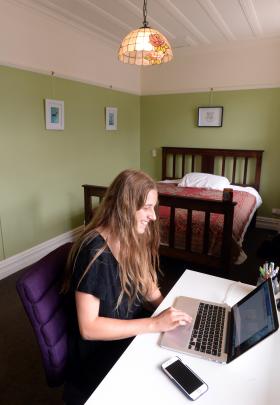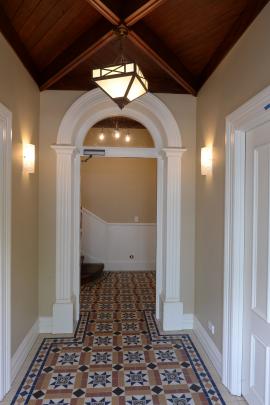Transforming a century-old brick building into modern accommodation has been a mammoth undertaking for a couple who studied in Dunedin in the 1980s. Kim Dungey reports.
It was the arch in the foyer that sold it. That and the stained-glass windows either side of the front door.
A 1914 property that had been converted to commercial premises in the 1970s was not what John and Rosamond Bridgman had in mind when they began looking for a student flat for their daughter.
But an online advertisement for the Dunedin building showed beautiful architectural features and those, combined with the central location, convinced them to buy it sight unseen.
It was a bold move, as its redevelopment took more than a year and, together with the purchase price, cost the Tauranga couple more than a million dollars.
Finally it reverted back to a residential property for the first time in more than 40 years last year, with the arrival of six university students, including their daughter, Frances.
The renovation retained the original staircase, stained-glass windows and arch the Bridgmans had admired, and married them with modern features, such as double glazing, solar panels and north-facing living areas.
The couple have named the six-bedroom, five-bathroom Frederick St property Henton House after its designer and first owner, Henton Macaulay Davey (1851-1935), an engineer, architect and patent agent who designed churches and other buildings as well as gold-mining machinery for the Otago goldfields.
Davey, who married three times and had eight children, moved into the house with his family from further along Frederick St in 1914 and lived there until his death at 84.
It remained in his family until the early 1970s, after which commercial owners removed the chimneys and installed automatic doors and an access ramp at the entrance. Most recently, it was the Diabetes Otago building.
Davey was a man of means and his home was more than a plain townhouse, Dr Bridgman says. The stained-glass windows either side of the front door were "fancy for the day" and the jarrah floorboards were imported from Australia.
He and his wife took that approach and "carried it on a bit", adorning the house with even more Edwardian features. The additions included a wrought iron front fence, tessellated floor tiles, picture rails in the bedrooms and new stained glass to complement the existing windows.
Three lights in the foyer were donated by the owner of an Edwardian house that had been destroyed in the Christchurch earthquake. A secondhand front door found in a local’s back garden matched the one shown on the original architectural drawings but needed new stained-glass panels.
The house also got a new roof, plumbing and wiring. Kauri ceilings were removed, repaired and reinstated. Sash windows were taken out and double glazed. A ventilation system, a 7.5kW bank of solar panels, a 1000-litre hot water cylinder and a charging point for electric cars were modern additions.
The living room was moved from the ground floor to the back upstairs section of the house, where new windows and a north-facing deck take advantage of the sun and views.
Jarrah floor boards and rimu joists, lifted when the ground floor was replaced with a heated concrete floor, were recycled. Some became the flooring upstairs; others have been made into Edwardian-style furniture for the property, which will operate as a B&B when tertiary students are away over summer.
The building was also seismically strengthened to 100% of current new building standards (previously it was only 25%) by tying the new roof, new ground floor and existing first floor to the external walls and strengthening the interior with steel and timber beams.
That work should secure the future of a property that twice in the past has faced an uncertain future. In 2012, its owners, then Diabetes Otago and the Heart Foundation, went their separate ways after a crack was discovered and it was estimated the building needed $250,000 worth of strengthening work. Earlier, the premises were earmarked for demolition as part of the development of Dunedin’s one-way system.
Flatting in a character property is part of the "Dunedin experience" for out-of-town students but often the cost of that is "deprivation", Dr Bridgman says. In the case of the Frederick St property, they wanted to retain the character but also renovate the house to a high standard.
An oral and maxillofacial surgeon who studied in Dunedin in the 1980s and ’90s, he says the Cumberland St flat he lived in was often colder inside than outside.
"We had an outdoor toilet which would sometimes freeze over, and sarking for insulation. It was a classic Victorian house: it looked great and was full of character but was terrible to live in."
Buying a modern flat would have been easier and cheaper than the renovation project he and his wife had completed but not as much fun, he adds.
"We weren’t looking for a development project. But this house came along and we fell in love with the place."




















